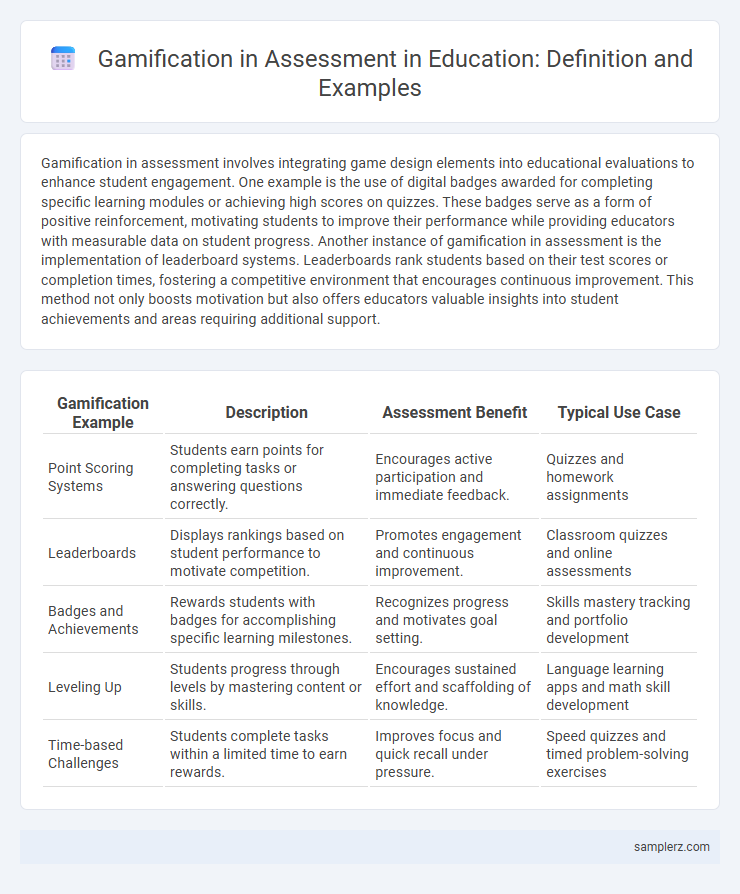Gamification in assessment involves integrating game design elements into educational evaluations to enhance student engagement. One example is the use of digital badges awarded for completing specific learning modules or achieving high scores on quizzes. These badges serve as a form of positive reinforcement, motivating students to improve their performance while providing educators with measurable data on student progress. Another instance of gamification in assessment is the implementation of leaderboard systems. Leaderboards rank students based on their test scores or completion times, fostering a competitive environment that encourages continuous improvement. This method not only boosts motivation but also offers educators valuable insights into student achievements and areas requiring additional support.
Table of Comparison
| Gamification Example | Description | Assessment Benefit | Typical Use Case |
|---|---|---|---|
| Point Scoring Systems | Students earn points for completing tasks or answering questions correctly. | Encourages active participation and immediate feedback. | Quizzes and homework assignments |
| Leaderboards | Displays rankings based on student performance to motivate competition. | Promotes engagement and continuous improvement. | Classroom quizzes and online assessments |
| Badges and Achievements | Rewards students with badges for accomplishing specific learning milestones. | Recognizes progress and motivates goal setting. | Skills mastery tracking and portfolio development |
| Leveling Up | Students progress through levels by mastering content or skills. | Encourages sustained effort and scaffolding of knowledge. | Language learning apps and math skill development |
| Time-based Challenges | Students complete tasks within a limited time to earn rewards. | Improves focus and quick recall under pressure. | Speed quizzes and timed problem-solving exercises |
Unlocking Creativity: Gamified Quizzes in the Classroom
Gamified quizzes transform traditional assessments by integrating interactive elements such as point scoring, leaderboards, and timed challenges, fostering enhanced student engagement and creativity. Platforms like Kahoot! and Quizizz enable personalized learning experiences that encourage critical thinking and problem-solving skills through game mechanics. This approach not only motivates students but also provides immediate feedback, promoting continuous improvement and deeper understanding of the subject matter.
Leveling Up Learning with Digital Badges
Digital badges serve as a powerful gamification tool in education by providing visual recognition for specific skills and achievements, motivating students to progress through learning levels. These digital credentials create a clear pathway for skill mastery and encourage continuous engagement by rewarding incremental accomplishments. Integrating badges into assessments enhances student motivation and provides educators with data-driven insights into learner progress and competencies.
Interactive Game Boards for Real-Time Feedback
Interactive game boards enhance assessments by providing real-time feedback, allowing students to visualize their progress and understand concepts more effectively. These tools incorporate elements like point scoring, timed challenges, and immediate response analysis to boost engagement and motivation. Adaptive algorithms within game boards tailor difficulty levels, promoting personalized learning experiences and deeper comprehension.
Leaderboards: Fostering Healthy Academic Competition
Leaderboards in educational assessments enhance student engagement by fostering healthy competition and motivating learners to improve their performance. By displaying rankings based on quiz scores or assignment completion times, leaderboards encourage continuous effort and peer-driven progress. This gamified element not only boosts academic achievement but also promotes a dynamic and interactive learning environment.
Escape Rooms: Engaging Assessments Beyond Traditional Tests
Escape rooms in education transform assessments into immersive problem-solving experiences where students apply knowledge to unlock clues and complete challenges, promoting critical thinking and collaboration. This gamified approach increases engagement by integrating curriculum concepts into interactive puzzles, enhancing retention and motivation. Studies show escape room assessments can improve student performance and foster deeper understanding compared to traditional testing methods.
Story-Based Assessments: Narrative-Driven Gamification
Story-based assessments in education utilize narrative-driven gamification to enhance student engagement and comprehension by embedding assessment tasks within an interactive storyline. These assessments often incorporate branching scenarios, role-playing elements, and immediate feedback mechanisms to simulate real-world challenges, fostering critical thinking and problem-solving skills. Research indicates that narrative-driven gamification improves retention rates and motivation compared to traditional testing methods.
Progress Bars: Visualizing Student Achievement
Progress bars in assessments provide students with immediate visual feedback on their learning progress, enhancing motivation and engagement. These dynamic indicators track completion rates and mastery levels, allowing learners to set goals and monitor their advancement in real time. Integrating progress bars in educational platforms boosts self-regulation and fosters a growth mindset by making achievement tangible and transparent.
Peer Challenges: Collaborative Gamified Assessments
Peer Challenges in gamified assessments enhance student engagement by encouraging collaborative problem-solving and competition among classmates. These assessments use point systems, leaderboards, and real-time feedback to motivate learners while fostering critical thinking and teamwork skills. Integrating peer challenges into educational platforms improves knowledge retention and creates a dynamic learning environment.
Mobile Apps Transforming Homework into Play
Mobile apps like Kahoot and Quizlet turn traditional homework into engaging games, boosting student participation and retention. By integrating quizzes, leaderboards, and instant feedback, these platforms gamify assessments to make learning competitive and interactive. This approach increases motivation and improves educational outcomes by blending play with skill evaluation.
Role-Playing Simulations for Deeper Understanding
Role-playing simulations enhance assessment by immersing students in realistic scenarios, promoting critical thinking and problem-solving skills. These simulations encourage active learning through decision-making and collaboration, allowing educators to evaluate students' comprehension and application of knowledge beyond traditional tests. By integrating gamification in assessments, role-playing fosters deeper understanding and engagement in complex educational content.

example of gamification in assessment Infographic
 samplerz.com
samplerz.com